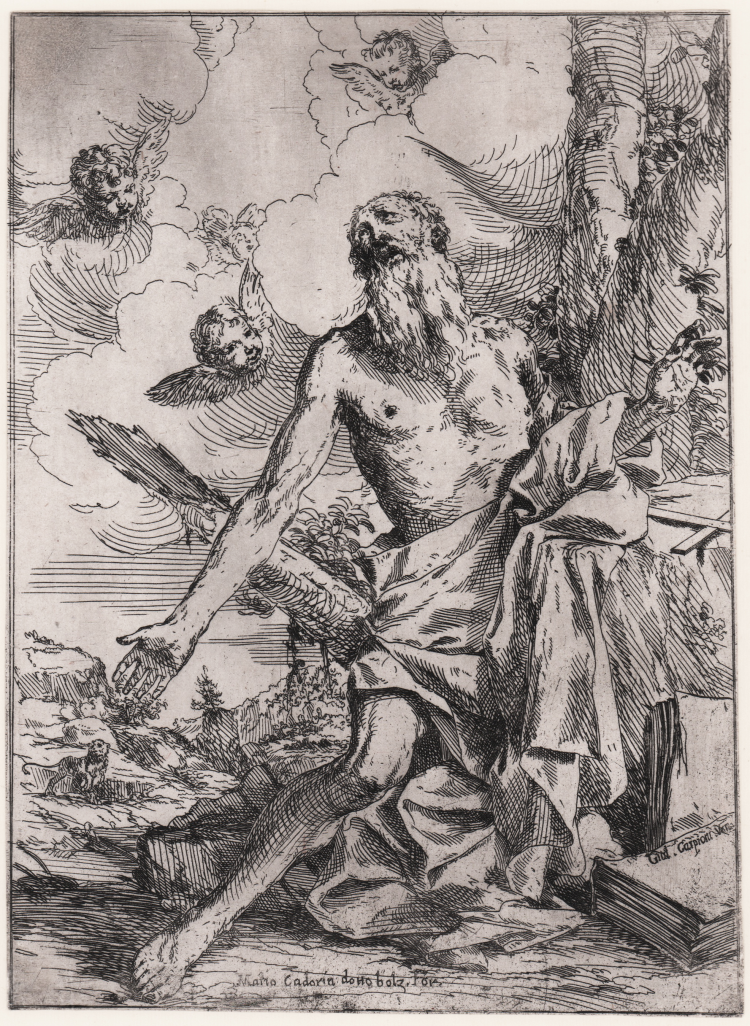



| Reference: | S37772 |
| Author | Giulio CARPIONI |
| Year: | 1655 ca. |
| Measures: | 162 x 223 mm |



| Reference: | S37772 |
| Author | Giulio CARPIONI |
| Year: | 1655 ca. |
| Measures: | 162 x 223 mm |
Etching, 1640 – 1655 circa, signed diagonally on a book at lower right: 'Giul. Carpioni. Ven.' and inscribed at lower centre: 'Matio Cadorin dotto bolz. For.' Second state of two.
Good example, printed on contemporary laid paper, on verso collection mark (similar to Lugt 3618, Louis-Antoine et Véronique Prat), in very good condition.
|
Bartsch XX.185.12; Bellini and Wallace in TIB 1990, 4504.012.S2; Calabi 1921, no. 7; Pilo 1961, no. 11; Mazzoli 2008, no. 12
|
Giulio CARPIONI (Vicenza 1613 – 1679)
|
Follower of Parmigianino and afterwards of Ottino, whose influence led him to know Caravaggio, Carpioni was one of the most interesting artists of the XVII century neo-Venetian Classicism in Northern Italy. He put together various experiences coming from different Regions in Italy (Realism from Lombardy, classicims from Bologna and Poussin) to reach his peculiar and particular style among the most interesting in the contemporary Venetian painting; we have evidences of it in his Bacchanalia and in the landscapes with Nynphs and Satyrs.
These subjects can be found also in some etching Carpioni realized; he was really fond of this particular technique, although he realized just a few pieces. His etchings, in any case, are extremely rare and they all reveal the influence Poussin had on his classicism and also the interest in Pietro Testa and Giovanni B. Castiglione.
Caprioni is mainly famous for his paintings; his activity as etcher can be considered a sort of experimentation in his young age.
|
|
Bartsch XX.185.12; Bellini and Wallace in TIB 1990, 4504.012.S2; Calabi 1921, no. 7; Pilo 1961, no. 11; Mazzoli 2008, no. 12
|
Giulio CARPIONI (Vicenza 1613 – 1679)
|
Follower of Parmigianino and afterwards of Ottino, whose influence led him to know Caravaggio, Carpioni was one of the most interesting artists of the XVII century neo-Venetian Classicism in Northern Italy. He put together various experiences coming from different Regions in Italy (Realism from Lombardy, classicims from Bologna and Poussin) to reach his peculiar and particular style among the most interesting in the contemporary Venetian painting; we have evidences of it in his Bacchanalia and in the landscapes with Nynphs and Satyrs.
These subjects can be found also in some etching Carpioni realized; he was really fond of this particular technique, although he realized just a few pieces. His etchings, in any case, are extremely rare and they all reveal the influence Poussin had on his classicism and also the interest in Pietro Testa and Giovanni B. Castiglione.
Caprioni is mainly famous for his paintings; his activity as etcher can be considered a sort of experimentation in his young age.
|